Ensenada, Baja California 作者: 来源: 发布时间:2021-11-10
1.Population and Area
Pop: 522,768
Area: 52.482 km2
Elev: 52 masl
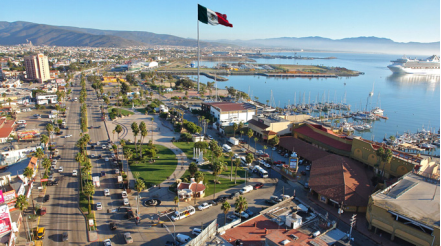
Ensenada location in Mexico within the state of Baja California
https://goo.gl/maps/MdHYDz1t2njVvnV7A
2. Natural geography
Nature and weather
Hydrography
Ensenada only has two bodies of fresh water: the Emilio López Zamora dam and La Lagunita, located north of the Ciprés military air base whose importance is of an ecological nature.
The Emilio López Zamora dam was built in 1976 by the Federal Government, in order to promote the control of avenues and supply for drinking water in Ensenada. In some years the dam has been affected by the lack of rain, which is why low water levels are observed. The dam has been used for National Olympics in kayaking and canoeing competitions.
La Lagunita del Ciprés (La Lagunita) is the last wetland of its kind in the history of Ensenada and is characterized by being surrounded by urban sprawl. It has around 4 hectares of surface and is supplied mainly from the water of the winter rains, which runs from the surrounding hills to the sea through small streams. Its volume of water varies depending on the season of the year, being during the months of December and January when more water accumulates and between October and November when its level decreases, thus comprising an annual cycle.
With the aim of ensuring the water supply for Ensenada, on June 10, 2018, a desalination plant with a capacity of 250 liters per second began operating. The project had an investment of 987 million pesos and consisted of the construction of the desalination plant from reverse osmosis, seawater capture works, pre-treatment facilities and a brine discharge system to the ocean, as well as a tank storage, pumping plant and conduction lines to the Ensenada water distribution system.

Flora and fauna
Many of the terrestrial or marine species inhabiting the surrounding the Greater Ensenada area in the Baja California islands are unique. Guadalupe Island, off the coast of the city, is one of the best places in the world for observing the great white shark. The island has been a wildlife sanctuary since 1975.
The city's offshore is host to an array of aquatic mammals including the gray whale, the Guadalupe fur seal and California sea lion; terrestrial mammals include various squirrel species, otters, the ring-tailed cat, coyote, bobcat, and puma.
Bird species include hawks, pelicans, roadrunners, and various waterfowl and oceangoing species.
Fish include tilapia, rainbow trout, leopard shark, and the great white shark.
Köppen Classification: Tropical and Subtropical Desert Climate
This climate type occurs primarily on the periphery of the true deserts in low-latitude semiarid steppe regions. It is transitional to the tropical wet-dry climate on the equatorward side and to the mediterranean climate on its poleward margin, with a cooler, wetter winter resulting from the higher latitude and mid-latitude frontal cyclone activity. Annual precipitation totals are greater than in tropical and subtropical desert climates. Yearly variations in amount are not as extreme as in the true deserts but are nevertheless large.
The Köppen Climate Classification subtype for this climate is "BSk". (Tropical and Subtropical Steppe Climate).
The average temperature for the year in Ensenada is 63.0°F (17.2°C). The warmest month, on average, is August with an average temperature of 71.6°F (22°C). The coolest month on average is December, with an average temperature of 55.8°F (13.2°C).
The highest recorded temperature in Ensenada is 102.2°F (39°C), which was recorded in May. The lowest recorded temperature in Ensenada is 32.0°F (0°C), which was recorded in January.
The average amount of precipitation for the year in Ensenada is 8.9" (226.1 mm). The month with the most precipitation on average is February with 2.3" (58.4 mm) of precipitation. The month with the least precipitation on average is July with an average of 0.0" (0 mm). In terms of liquid precipitation, there are an average of 25.9 days of rain, with the most rain occurring in January with 4.6 days of rain, and the least rain occurring in June with 0.0 days of rain.
https://www.weatherbase.com/weather/weather-summary.php3?s=5067&cityname=Ensenada%2C+Baja+California%2C+Mexico&units=
Getting there and around
Get there
By plane – Ensenada Airport (IATA: ESE, ICAO: MMES) is a public, commercial airport that also functions as the "El Ciprés" Military Airbase Number 3, operated by the Mexican Air Force. It is located 3 km south of Ensenada, Baja California, Mexico. Besides military air operations, it handles general aviation services for the city of Ensenada. It is an official airport of entry into Mexico. Currently, it only handles two regional commercial airlines, with flights within the region.
By car – Drive across the border from San Ysidro. Go in the morning and you will be going the opposite direction of the nigtmare traffic trying to get into the U.S.. Once in Tijuana, follow the signs to Rosarito and Ensenada on route 1. There will be three toll stops en route to Ensenada. These tolls cost 31 pesos, less than US$2, each. You can pay with US dollars or pesos, but no mixed currency. The scenic highway ("carretera escenica") is well maintained and is an enjoyable ride along the beautiful Baja coastline. If you go in spring and early summer, the wildflowers on the hillsides are gorgeous. The ride from Tijuana to Ensenada takes approximately 1-1.5 hours. Stop in Puerto Nuevo for a Mexican lobster dinner. There are many rest areas and vista points along the way. AAA and other travel magazines recommend that you only drive in Mexico during the day for safety reasons. The toll road (scenic highway) is somewhat winding compared to divided highways in the United States or Europe, but a great improvement over two-lane roads south of Ensenada.
By bus – Take the bus from Tijuana for roughly US$15 or 210 pesos.
Cruise ships – Ensenada has become a regular stop for several lines of cruise ships since the 1980s. Although this is certainly the most expensive means to travel to Ensenada, it is also most enjoyable.
https://en.wikivoyage.org/wiki/Ensenada
Car Rental – To explore Mexico’s provincial towns and cities—including its beach locations and the scenery and attractions near them— consider renting a car for your visit. Having your own car will give you more flexibility than using public transport options and, in some cases, offer you access to places which are otherwise difficult to visit without the use of a car.
There are several car rental agencies. Rent something modest and unassuming.
COVID19 - International entry into Mexico from United States
Allowed for: All visitors arriving by air. Mexico land borders are closed to non-essential travel
Restricted for: There are no current restrictions.
Get around
By foot – Most of Ensenada's downtown tourist attractions can be accessed by foot. Others, like La Bufadora and Wineries are too far away to walk to, but tours will take you there for a fee. If your espanol is "malo" you could take local buses inexpensively out and back to La Bufadora.
Local Buses – Local buses and mini-buses (combis or micros) are available locally for a fraction of the cost of a taxi around town. You need to speak Spanish to be able to ask for directions or ask the driver to tell you where to get off.
Carnival shuttles – Carnival Cruises has the Misioneros Tour company run shuttle buses between the port and Ensenada every 10min. It's US$2 to Ensenada and US$2 to get back to the ship. US$4 round-trip.
Taxis – Taxis in most of Mexico’s towns and cities are not metered, so agree your price before you get in. Taxi travel is very affordable in Mexico, in comparison to the USA, Canada and Europe, and so provides a viable means of public transportation in Mexico. Your hotel can arrange taxis for you; some post their rates on a board in the lobby; taxi hotel rates are usually higher than cabs you hail off the street. If you speak Spanish, you will have a distinct advantage and be able to negotiate a price with the driver.
Uber is expanding rapidly across Mexico and now offers services in cities across the country, including: Mexico City, Toluca, Cuernavaca, Puebla, Querétaro, León, Aguascalientes, San Luis Potosí, Guadalajara, Monterrey, Hermosillo, Tijuana, Mexicali, and Mérida. Uber has been adding Mexican cities to its network every year, check for availability when you arrive at your destination in Mexico.
Cabify and Didi are also developing and currently operate in cities including Mexico City, Toluca, Monterrey, Puebla, Querétaro and Tijuana. Check for availability in the city you are visiting.
These services offer people with smartphones a way to book a cab through a mobile app for a pre-agreed price. Fares are comparable with Sitio type cabs, and sometimes trade at a premium to this when local demand increases.
https://www.mexperience.com/transport/taxi-travel-in-mexico/#51
3. ECONOMY
GDP: 60,708 M MXN
https://cemdi.org.mx/sitio/publicationes_cemdi.aspx#research_white_books_0
4. Industry characteristics
Ensenada's economy is driven by trade, such as commercial fishing, tourism, agriculture, mining, and, to a lesser extent, the maquiladora industry. Some of the international companies that manufacture in Ensenada are Fender, Navico and Allegion.
Ensenada's commercial activity is mainly oriented to the domestic market. Between 46% and 44% of the establishments are engaged in the retail trade of non-food products, food and tobacco, and absorb between 43% and 30% of the staff and between 30% and 18% of commercial sales.
Research and manufacturing
Ensenada is developing scientific research and natural science sectors, with special focus in the marine sciences sectors. Ensenada is claimed to be the city with the highest number of scientists per capita in Latin America. The Center of Scientific Research and Higher Education of Ensenada (CICESE) conducts research in Earth Sciences, Applied Physics, Oceanography, Communications and Experimental and Applied Biology. Further research is conducted on the campus of the Autonomous University of Baja California, Ensenada (UABC), mainly in Oceanography and education areas although there are groups in Physics, Biology, and other related sciences. The National Autonomous University of Mexico (UNAM) has a research campus in the city. The campus hosts the Institute of Astronomy and the Centre for Nanosciences and Nanotechnology (CNyN). The National Astronomical Observatory (Mexico) is located on the mountains of the Sierra de San Pedro Martir, south of the city.
The city is home to the largest cluster of bio-medical device companies in Mexico and is a developing center that is drawing a growing number of biotech researchers.[18] Unique to the city is that its biotech cluster is near that of another, larger, cluster in San Diego. The proximity of these two biotech clusters fuels their interaction.
The city is not part of any rail transport grid with which it could use to transport cargo and other materials, although there are plans to build a rail line to the United States border in the short to mid-term future that would link it to San Diego–Tijuana. Unlike the larger cities to the north, Ensenada has only six major industrial parks, compared to 26 in Mexicali and 51 in Tijuana, as its economy is more focused on tourism and technology. Fender guitars and Lowrance fishfinders are manufactured in Ensenada.
Tourism
Ensenada is located some 108 kilometres (67 mi) south of the border with the United States, connected via a four-lane toll road MX-1D and a two lane free road, which makes it a natural destination for tourists on short vacations by car. Ensenada's proximity to California also makes it a destination for short cruise ship trips from Port of Los Angeles and Port of Long Beach. As of 2005, four cruise lines maintained ships that docked in Ensenada weekly, though, one of these ships—the Monarch of the Seas, operated by Royal Caribbean Cruise Lines—ceased operations in the Pacific in mid-October 2008. The world-renowned Baja 1000 off-road race is held in Ensenada every year in late November, while the Baja 500 race is held in early June. Off-road enthusiasts use Ensenada year-round as a starting point to explore Baja California.
Watersports and ocean proximity have formed an integral part of the structure of tourism and its relation to economics in the city. Ensenada and coastal beach towns of Greater Ensenada have several renowned surfing spots, such as San Miguel Beach, California Trailer Park, Stacks and 3 M's (Tres Emes in Spanish), which are located on the north coast of the city. Maritime activities associated with the city also include the global Newport to Ensenada International Yacht Race, billed as the world's largest international sailing event, which begins in Newport Beach and finishes in Ensenada.
The nearby historical mission town of Guadalupe, was revitalized from 1905 to 1910 with immigrant Spiritual Christians, mostly Pryguny from the Caucasus, South Russia. After WWII most moved to California to join more prosperous relatives, while many who remained intermarried with Mexicans and live in Ensenada and Tijuana. Two families remaining in the Guadalupe Valley opened museums, a cafe, and participate in wine tourism. The traditional economic activities in Guadalupe are olive and wine production. Currently, about 90% of wine production in Mexico originates in the valleys of Guadalupe and adjacent Calafia.
Maritime industry
The Port of Ensenada has a large influence on the civic economy. Ensenada is home to the only deep-water port in the state of Baja California and on the Baja California Peninsula. The port is part of standard shipping routes that directly link it with the Mexican cities of La Paz, Manzanillo, Mazatlán, Acapulco and Lázaro Cárdenas; the American cities of San Diego, Long Beach and Los Angeles; the Guatemalan city of Puerto Quetzal, the Chilean city of Valparaíso, the Japanese city of Yokohama, and the city of Hong Kong. Ensenada is where the Fender standard series guitars and basses are produced.
In addition to revenue generated by docking cruise ships, fishing accounts for a large part of the economy. More than 90 species of fish are commercially fished in Ensenada; the most important fisheries are tuna, shrimp, California spiny lobster, abalone, sea urchin, sardine, mackerel and seaweed. A large percentage of all catches are exported to East Asia. A tuna embargo imposed on Mexico during the 1990s caused most of the fishing fleet to relocate to the ports of Guaymas, and Mazatlán, further south. To survive, Ensenada's tuna industry has shifted its focus to tuna farming, exporting the highly valued meat almost exclusively to Japan. Ensenada has been known for sports fishing over 50 years. Each year hundreds of anglers head for Ensenada to go fishing and take advantage of the shorter distances needed to travel by sea to get to the big catch.
Agriculture
The municipality of Ensenada has three main agricultural zones: the Guadalupe-Calafia valleys to the north, the Ojos Negros valley to the east and the San Quintin valley to the south. The main crops are grapes, olives, tomato, wheat, alfalfa, asparagus, green onions and broccoli.
Mining
One of the earliest activities in the Ensenada region was gold and silver mining, and some of these mines remain in limited operation. In recent years, very large amounts of gravel have been extracted from creek beds in rural areas and exported for infrastructure works in California in the US. However, this has been a controversial activity, as environmentalists have argued that depleting the creekbeds will decrease the amount of water that is absorbed by the soil during the brief rainy season, negatively impacting the agriculture. As of November 2005, the extraction of gravel remains unchecked. Said extraction activities have been linked to former Governor Ernesto Ruffo.
Key project: desalination plant in Ensenada, Baja California Sur
The project consists of the provision of services for the capture and desalination of sea water, its purification, conduction and delivery of 250 liters per second, as well as the disposal of reject water, in the Municipality of Ensenada, Baja California. It includes the design, preparation of the executive project, construction, electromechanical equipment, functional tests, operation, maintenance and conservation of the desalination plant to satisfy the delivery of water, in the quantity and quality required.
The project is operational already, and is carried out through a Public Private Association, respectively. The company that operates it will receive a consideration with a fixed and a variable component based on the amount of water desalinized. At the end of the established 20-year period, the company must cede the plant to the municipal government or apply to the contest for the reassigning of the concession, in 2038.
The joint investment amount is 900 million pesos, approximately.
https://www.proyectosmexico.gob.mx/proyecto_inversion/0839-planta-desaladora-de-ensenada
5. Attractions
La Bufadora
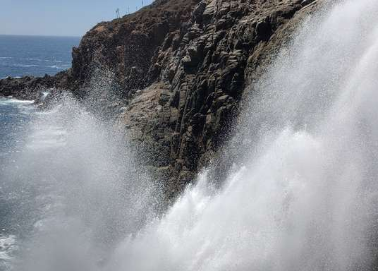
La Bufadora is a marine geyser or blowhole and it is one of the largest blowholes in North America. It’s located in a small village about nineteen miles southwest of town.
The road from Ensenada, especially in the area close to the Bufadora, offers beautiful views over the sea and cliffs. The narrow main street leading to the viewing area is crowded with tourist-trap shops selling curios, take-away food, and prescription medicines, but the Bufadora is a rather remarkable natural sea vent. However, it is not possible to see the actual blow hole from most parts of the viewing area due to the angle of the cliff face; the impressive columns of water that shoot up are visible. On busy days, local Mexican tourists in the hundreds cram the viewing area. The local cove offers camping, swimming, kayaking and scuba, including a small dive shop with rentals; the cove is especially cold water. Locals report that sea lions are sometimes seen swimming about. Locals eat at Celia's, also available are the Bufadora, Pancho's, and Habana Banana restaurants.
Ensenada Wineries
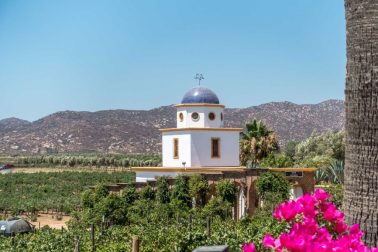
The wine growing region of Baja California lies within the valleys of San Vicente , Santo Tomás and Guadalupe , all located in the municipality of Ensenada . Today more than 90% of Mexico 's table wines are produced here, one of the most famous Baja Winery being Bodegas de Santo Tomas, founded in 1888. Much of the Baja California peninsula has a semi-desert climate, but Ensenada 's region has a cold marine current, which helps to produce a Mediterranean climate, which is ideal for growing wine grapes. With its warm summers and mild winters, not to mention sunny days and cool nights during the growing season, these valleys produce fine Mexican wines with a style of their own. The wine makers of the Ensenada region produce a complete range of types and styles of wines. Mexican wines from this area have obtained international recognition, and are being exported to Europe, the United States and Canada in ever increasing quantities. Most Baja wineries offer tours and wine tasting.
https://www.mexbound.com/ensenada-wineries
Cañón De Doña Petra Ecological Park
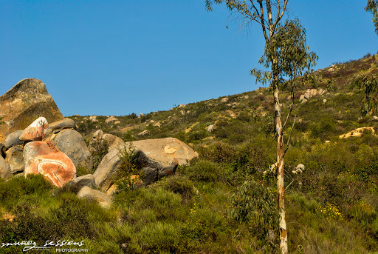
Canon De Dona Petra Ecological Park is a nature park located in an elevated residential area and is a popular tourist attraction in Ensenada. Most people come to the park to enjoy sweeping views of the city and the beautiful coastline of Baja California. The park is an ideal place to relax with a good book or get a little more active and go walking, hiking, or mountain biking along a network of trails. Birdwatchers will also enjoy the park as it is home to several species of local birds. Central to the park is a very bright and colorful statue of the Buddhist Princess Tara, which was donated to the city by the people of Nepal.
https://vacationidea.com/vacation-ideas/things-to-do-in-ensenada.html
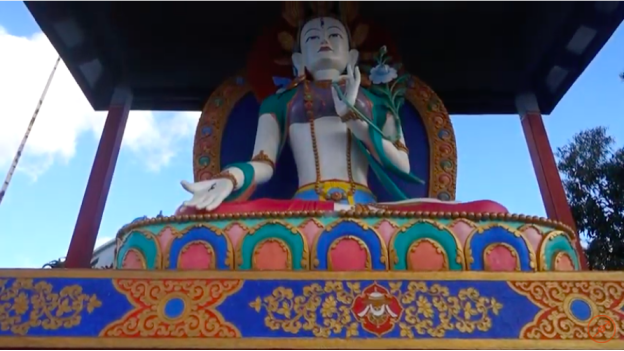
ENSENADA, MEXICO | Best Things To Do in this Baja California Gem
https://youtu.be/1c0sVp9PPUA
6. History
At the time the first European explorers arrived in the region, the Yuman people inhabited the region. Yuman tribal groups such as the Kiliwa, Paipai and Kumeyaay still exist. These semi-nomadic indigenous people lived in the bay area and interior valleys of the Sierra de Juárez and San Pedro Mártir. The Kumeyaay had a village where the city is seated on, which was called Pa-tai.
Bahia Todos Santos, which Ensenada now borders, was first reached by sea by the Spanish explorer Juan Rodríguez Cabrillo on the vessels El Salvador and Victoria. The city was founded September 17, 1542 under the name San Mateo. In 1602, while mapping the coast of the Californias in search of safe harbors for returning Spanish galleons from Manila to Acapulco, Sebastián Vizcaíno renamed the city to Ensenada de Todos Santos. Ensenada means "bay" or "cove".
The first permanent settlement was established by the Jesuits during the 17th or 18th century. After the expulsion of the Jesuits in 1768, the Dominicans took over the representation of Europe in what is now Ensenada. In 1805, José Manuel Ruiz Carillo obtained permission to establish himself in Ensenada, being appointed governor of Baja California and building in Ensenada a house that survived until the final part of that century, despite being briefly taken by William Walker, the self-declared "president" of the Republic of Lower California, in 1853–54.
In 1882, Ensenada was designated the capital of Baja California, and attempts at developing the area were made by the English Mexican Land and Colonization Company. These were interrupted by the Mexican Revolution, which left the area devastated. In 1915, the capital was transferred to Mexicali, and in 1930, the population of Ensenada was only 5,000. During the early part of the twentieth century, the city's name was shortened from Ensenada de Todos Santos to Ensenada, a change made in order to avoid confusion with Todos Santos in Baja California Sur.
The twentieth-century development of Ensenada was assisted by prohibition, which sent Americans and Canadians south of their border in search of entertainment and alcohol, developing first Tijuana, then Rosarito, and finally Ensenada as tourist destinations. The Hotel Riviera del Pacífico was opened in 1930, briefly placing Ensenada on the international glamor map and was visited several times by President Miguel Aleman, international artists and political personalities; yet unlike the Hotel del Coronado, it was never a sustained success (despite giving rise to the claim that the Margarita was invented there). It really flourished only in the early 1950s, at which time Ensenada's population had risen to 20,000. The hotel finally closed in 1964. It was later reopened as a cultural center and museum. By this time, other hotels had opened, and the population and economy of Ensenada had grown and diversified towards their present status.
On January 26th, 2007, Pope Benedict XVI created the Roman Catholic Diocese of Ensenada with territory taken from the Archdiocese of Tijuana and Mexicali Diocese, making it a suffragan diocese of the Metropolitan Church of Tijuana.
7. Other Information: Ensenada’s diversity
Ensenada's diversity as a city is in part attributed to Spanish, Russian, and American influences. Spanish missionaries and Russian settlers began the growth of the wine industry in the city. Reminiscent of this time period are Russian museums in the city.
The city is known for its festivities and laid-back atmosphere, the city hosts many events including the Wine Harvest Festival (Fiestas de la Vendimia) and Ensenada Carnaval. The Wine Harvest Festival celebrates the wine harvest season and in the city and nearby Guadalupe Valley, a series of events takes place.
Typical food in Ensenada consists of fish tacos, which originated in the city, shrimp tacos, and ceviche. These dishes are usually accompanied by avocado and salsa. Another dish characteristic of the port city is carpaccio. The city's Mediterranean climate allows for the cultivation of grapes and olives, which in turn make wine and olive oil, respectively. Development of such foods complement Spanish, Italian, French, and Mexico dishes in Ensenada.
8.Contact Information
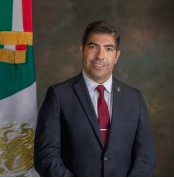
City Mayor: Armando Ayala Robles
Contact number: +52 (646) 172 3401
Govt. Office Address: Carretera Transpeninsular 6500 A, Ex. Ejido Chapultepec C.P. 22785, Ensenada, Baja California
FB: https://www.facebook.com/ArmandoAyalaRobles
Twitter: https://twitter.com/ArmandoAyalaRob
Website: http://www.ensenada.gob.mx
